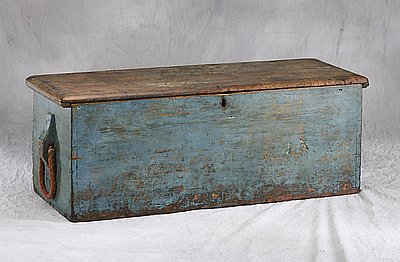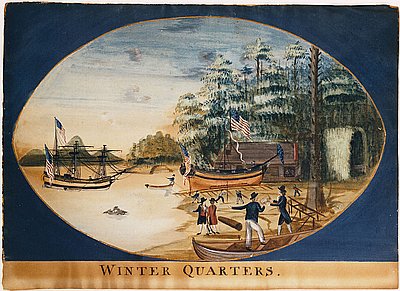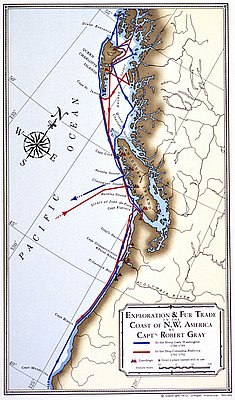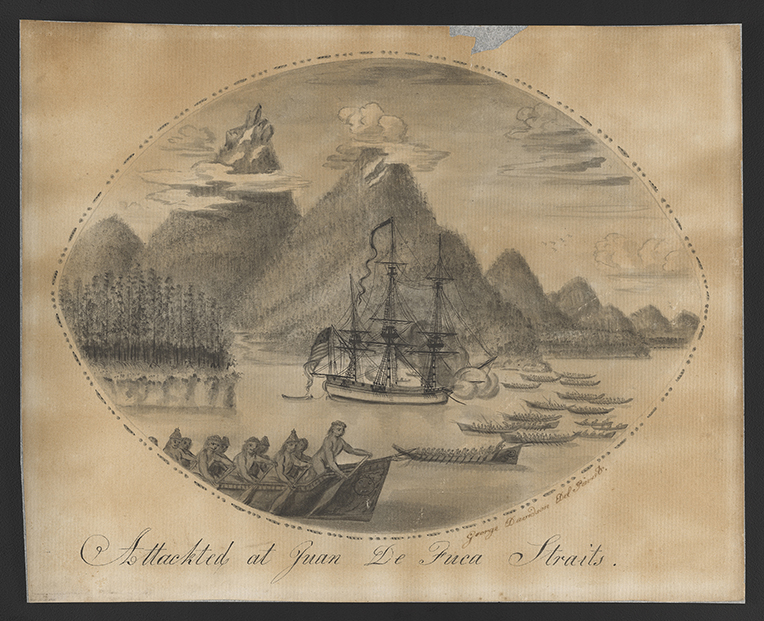- Catalog No. —
- Columbia Rediviva Coll., Mss 957, box 1, folder 19
- Date —
- 1792
- Era —
- 1792-1845 (Early Exploration, Fur Trade, Missionaries, and Settlement)
- Themes —
- Exploration and Explorers, Native Americans, Trade, Business, Industry, and the Economy, Transportation and Communication
- Credits —
- Oregon Historical Society Research Library
- Regions —
- Coast Oregon Country
- Author —
- George Davidson
"Attackted at Juan de Fuca Straits."
One of the oldest non-Native collection items in the Oregon Historical Society is an ink-wash sketch by artist George Davidson depicting the trade ship Columbia Rediviva in 1792, anchored in what is now North Bay, or Gray’s Harbor, on the Washington Coast. The ship sits in the water and is surrounded by canoes full of Native people. The caption reads: “Attackted at Juan de Fuca Straits.”
The Columbia Rediviva was a privately owned American ship captained by Robert Gray, an experienced commercial mariner hunting for pelagic furs. Gray’s extensive trading missions would make him the first American ship captain to circumnavigate the globe and the head of the first non-Native expedition to cross the Columbia Bar into the “Great River,” which he did a few days after leaving the straits. That feat kept the dream of the Northwest Passage alive for a few more years (Lewis and Clark would kill the dream in 1805) and made possible, in part, the American claim on the Oregon Country.
Gray’s journeys are well-documented by crew members, so we know what happened the day the Columbia Rediviva sailed into what was then an uncharted bay south of the Juan de Fuca Straits. Fifth mate John Boit, who was a teenager at the time, maintained the logbook and wrote that the ship was met by canoes with Native men and women, likely Chehalis. Boit was convinced that the crew members were the “first Civilized people” to visit the harbor, as the sailors were greeted by the “greatest astonishment.” Still, sea-going vessels meant trade was possible, and by the next day the Americans had exchanged blankets and iron for “a great many” furs and fish.
During the night, the nervous crew observed several canoes approaching the ship and so fired warning shots. When the “war Hoops” persisted, they aimed the canons directly at a canoe and exploded it to pieces, likely killing all aboard. The Indians retreated. The log for the next morning, May 9, begins with the observation, “Very pleasant weather.”
Boit recorded that Chehalis approached the ship to see the weapon that had blown up the canoe. They also traded fish and fur before the Columbia pulled anchor and left the bay. Boit wrote: “I am sorry we was oblidged [sic] to kill the poor Devils, but it cou’d not with safety be avoided.” It is unclear if the Chehalis intended to attack the ship—whose crew they traded with before and after the event—or if the “war hoops” Boit heard signified what he assumed they did. It is also unlikely that the warning shots would have communicated their purpose to people who had never seen American technology of that kind.
The sketch and the logbook account for each other well enough to match one with the other, and we learn much from both artifacts. The sketch captures both the vulnerability and the technological power of American sailing vessels in the Pacific, surrounded by danger but persistent in their nationalistic strength and purpose. Artists were brought on board to document and memorialize the voyages, and it is significant that Davidson memorialized this moment, unencumbered by the incongruity of the trading relationship that had been established. To eighteenth-century EuroAmerican audiences, it would have been apparent that the Indians were the aggressors, despite the absence of weapons and the bloom of cannon fire from the ship. The narratives of racial superiority and conquest were inscribed on the American worldview over and over again.
Boit’s account gets us closer to the reality. As modern readers, we can see the moments of possible misunderstanding and ignorance, and how dubious Boit's assertion was that violence was necessary. We also know that Gray used violence when it suited his goals, which were primarily economic, not nationalistic. He stayed to trade another day, despite the “attack.” This is significant, because it helps us understand that the main purpose of early trade on the North Pacific was not to colonize or conquer but to control and accumulate wealth. Those American aims are not apparent in the sketch. Certainly, encounters such as this one contributed to the colonization effort in material ways and, importantly, in the ways people read and heard about experiences that dehumanized Native people and valorized white traders and explorers. Those themes persist in American narratives and mythologies.
Further Reading
Columbia Rediviva collection; Mss 957; Box 1; Folder 19
Howay, Frederick W., Ed. Voyages of the Columbia to the Northwest coast, 1787-1790 & 1790-1793. Portland: Oregon Hist. Society Press, 1990.
Nokes, J. Richard. Columbia’s River: The voyages of Robert Gray, 1787-1793. Tacoma, Wash.: State Historical Society, 1991.
Scofield, John. Hail, Columbia: Robert Gray, John Kendrick and the Pacific Fur Trade. Portland: Oregon Hist. Society, 1993.
Written by A. E. Platt, © Oregon Historical Society, 2021
Related Historical Records
-
Robert Gray's Sea Chest
This chest is believed to have accompanied Captain Robert Gray on the second voyage of the Columbia Rediviva to the Northwest Coast, during which Gray made the first …

-
Winter Quarters
This work by American George Davidson is one a series of paintings in the museum collections at the Oregon Historical Society. Davidson produced the paintings in the mid …

-
Exploration & Fur Trade by Robert Gray
The Oregon Historical Society produced this map in 1972 to illustrate the voyages of Captain Robert Gray to the Northwest Coast in the late eighteenth century. Captain Robert …

